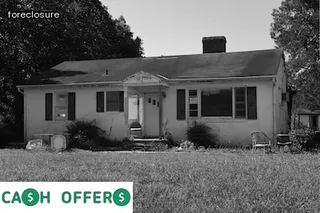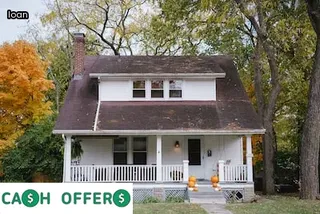Navigating the foreclosure process in North Dakota can be a complicated and stressful experience, but understanding the laws and procedures can help make the process smoother. Knowing the fundamentals of North Dakota's foreclosure rules is essential for any homeowner facing this situation.
In North Dakota, foreclosures are handled through non-judicial proceedings, which means that the court does not oversee or dictate the process. Instead, lenders have to follow state laws in order to pursue foreclosure on a property.
The most common form of foreclosure in North Dakota is mortgage foreclosure, which is initiated when a borrower fails to keep up with their payments. Once initiated, lenders must provide homeowners with certain notices and wait certain periods of time before they can move forward with selling the property at auction.
It's important to note that borrowers do have some rights during this process; if they are able to come up with enough money to pay off the loan before it reaches an auction sale date, they may avoid foreclosure altogether. For those who need further assistance navigating foreclosure in North Dakota, there are local housing counselors available to offer advice and information.

Exploring state and federal laws on foreclosure can be a daunting task, especially in North Dakota. That's why it's important to understand the legal process of foreclosure, as well as any applicable state and federal regulations that come into play.
It starts with understanding how lenders are allowed to proceed when homeowners default on their mortgages. Under the law, lenders must provide written notification that they intend to foreclose on a property if the borrower fails to make their payments.
This is typically done through a Notice of Default or Notice of Intent letter. Then the lender must follow certain regulations before they are allowed to proceed with foreclosure proceedings.
These include giving notice of the sale date, publishing public notices about the sale, and allowing time for potential buyers to submit bids for the property. Additionally, some states have additional requirements that must be met before a bank can move forward with foreclosure procedures.
Knowing these rules and regulations is essential for navigating North Dakota's real estate laws and procedures regarding foreclosure.
The foreclosure process in North Dakota can seem daunting and complicated, but with the right knowledge it can be navigated successfully. Preforeclosure is the first step in the foreclosure process, and involves a homeowner being notified by their lender that they are behind on their payments and need to bring them current.
In order to avoid foreclosure, homeowners must complete all paperwork associated with preforeclosure within the specified timeframe. The homeowner may also have the option to negotiate with the lender to obtain a forbearance or repayment plan that will help them catch up on missed payments.
Additionally, if a homeowner wishes to sell their home during preforeclosure, they can do so through a short sale or deed in lieu of foreclosure agreement with their lender. Knowing how to navigate real estate laws and procedures during preforeclosure is key for homeowners interested in avoiding full-on foreclosure proceedings.
Understanding which options are available to you during preforeclosure is essential for making sure your rights are protected throughout the entire process.

When it comes to the foreclosure process in North Dakota, understanding the timeline is essential for navigating local real estate laws and procedures. Typically, homeowners begin by receiving a Notice of Default from their lender or loan servicer.
This notice states that they are behind on payments and need to catch up within a certain amount of time; failure to do so will result in the initiation of foreclosure proceedings. Once the homeowner fails to make their payments, the lender can file a complaint with the local court system.
After this complaint is filed, homeowners have approximately thirty days to respond before a judgment is rendered. If this deadline passes without response from the homeowner, a judgment of foreclosure will be issued against them by the court.
The final step in the process is for a sheriff's sale to take place — at which point ownership is transferred from the former homeowner to another party. Homeowners should familiarize themselves with North Dakota's foreclosure laws and timelines in order to have the best chance of avoiding a foreclosure on their property.
Understanding common mortgage loan terms in North Dakota is essential for navigating the foreclosure process. When it comes to mortgages, the two most commonly used terms are principal and interest.
The principal amount is the total loan amount that was borrowed from a lender. Interest is the fee paid to a lender for providing the loan.
In North Dakota, lenders use an adjustable rate mortgage (ARM) as a common type of loan which provides borrowers with a lower initial interest rate than a fixed-rate option but can vary over time based on prevailing market conditions. Another important term to be aware of is escrow, which is money held by a third party in trust for both the buyer and seller until all conditions of a real estate sale have been met.
Furthermore, when considering foreclosure laws and procedures in North Dakota, it's important to understand lien priority which determines how different creditors will be paid if there are multiple liens attached to the property being foreclosed upon. By familiarizing yourself with these common mortgage loan terms, individuals can confidently move forward with understanding and navigating through the foreclosure process in North Dakota.

One of the most important steps in navigating North Dakota's real estate laws and procedures is to avoid missing mortgage payments. Being proactive and identifying potential problems before they become too large can help keep a homeowner on track with their payments.
To stay ahead of any potential issues, it is important to have a clear understanding of the foreclosure process in North Dakota. Knowing what documents are necessary for filing, as well as where to go for assistance, are key components to being an informed homeowner.
Additionally, being aware of the different types of protections offered by government programs can help ensure that homeowners stay on top of their mortgage payments and avoid foreclosure. Finally, maintaining communication with the lender is paramount; if any unforeseen financial issues arise, lenders may be able to provide relief or adjust payment schedules accordingly.
When it comes to the foreclosure process in North Dakota, homeowners must understand what a breach letter and preforeclosure notice are before diving into the real estate laws and procedures. A breach letter is typically sent by a lender when an individual fails to make their mortgage payments on time or has defaulted on their loan.
This type of letter outlines any late payments, the amount outstanding, and how long they have until foreclosure proceedings begin. On the other hand, a preforeclosure notice is issued when foreclosure proceedings are about to begin and it states that the homeowner must cure their delinquency within a set period of time in order to avoid having their property foreclosed upon.
Both types of letters can be intimidating for homeowners who are unfamiliar with North Dakota's real estate laws and procedures but understanding them is essential for navigating the foreclosure process effectively.

When foreclosure begins, the borrower is typically served a Notice of Default and Right to Cure. This document informs the borrower that they are in default of their mortgage payment and must take corrective action or risk losing their home.
The notice will outline the amount of time the borrower has to make their payments current before the lender can start foreclosure proceedings. In North Dakota, lenders must file an affidavit with the court as part of the foreclosure process.
Once this affidavit is filed, notice must be provided to all parties involved in the loan, including any co-signers, lienholders, and borrowers. During this period, homeowners have a chance to negotiate a repayment plan with their lender or explore other options such as refinancing or selling their property in order to pay off their debt.
Additionally, if there is sufficient equity in the home and it is marketed at a fair price, it may be possible for another buyer to purchase the property and cover some or all of what is owed on it. It is important for borrowers facing foreclosure to understand how different laws may affect them so they can take advantage of every opportunity available to them during this difficult time.
Reinstating the mortgage before sale is an important step in navigating through the foreclosure process in North Dakota. The first step is to get a full understanding of all applicable laws and procedures associated with the foreclosure process.
Once you have done your research, you must contact the lender and provide proof of your income, property value, and any other financial information that may be necessary. After submitting this information, the lender will determine if they are willing to reinstate the loan.
If so, they will provide you with a reinstatement agreement which outlines the amount you will need to pay in order to bring your mortgage current. You must then make sure that these funds are paid within the allotted time frame of 30-45 days or risk going into default again.
It is important to note that even if you successfully pay off your arrears, this does not guarantee that foreclosure proceedings will be stopped; however, it is still worth trying as it could save you from losing your home. Additionally, working with a lawyer or real estate professional can help guide you through this process and provide advice on how best to handle negotiations with lenders.

It is important to understand the redemption period after a foreclosure sale in North Dakota. Homeowners may be eligible for redemption during this period, so it is critical to be aware of the state's laws and procedures.
The first step to uncovering the foreclosure process in North Dakota is learning about the timeline for redemption. This can vary based on the type of loan and other factors, but generally lasts for six months from the date of the sale.
During this time, homeowners have an opportunity to redeem the property by paying off the full balance of their loan plus court costs and other fees. If they are unable to do so, they must still be aware of any additional rights they may have when it comes to redeeming their property.
It is also important to understand that there may be additional laws or procedures that apply depending on whether or not a third party purchased the property at auction. Knowing these details can help protect homeowners throughout their foreclosure process while navigating North Dakota real estate laws and procedures.
Navigating the foreclosure process in North Dakota can be a daunting task. However, understanding the real estate laws and procedures involved can help you take steps to protect your home from foreclosure.
The first step is to familiarize yourself with North Dakota’s foreclosure laws and processes. There are several legal options available to stop or postpone a foreclosure, such as filing for bankruptcy, applying for a loan modification or forbearance agreement, or filing an appeal with the court.
While each option has specific requirements and qualifications, they all have the potential to put an end to proceedings and keep your home out of foreclosure. Additionally, it may be possible to negotiate with creditors outside of court by proposing a payment plan that works for both parties.
Finally, it may be possible to get help from government or non-profit organizations that provide services such as credit counseling or legal advice on how to handle foreclosures in North Dakota. Taking advantage of these options could give you the time and resources needed to protect your home from foreclosure and keep it in your possession.

When pursuing a foreclosure in North Dakota, it is important to understand the state's deficiency judgment laws. A deficiency judgment allows the lender to demand payment for any remaining balance after a foreclosed property has been sold at auction.
In North Dakota, lenders are able to obtain a deficiency judgment if they can prove that their loan was secured by the property and that they followed all proper procedures when initiating the foreclosure. If a court finds that the lender has met these criteria, it will issue a deficiency judgment that requires the borrower to pay back any remaining balance on their loan.
To avoid a deficiency judgment, borrowers should be sure to work with an experienced attorney and keep up on their payments until the foreclosure has been completed. Additionally, borrowers should be aware of other potential risks such as eviction from the foreclosed property and further legal action if payment is not made according to the court order.
Understanding these laws and procedures is essential for navigating real estate foreclosure in North Dakota successfully.
In North Dakota, homeowners facing foreclosure have certain rights that should be taken into consideration. Foreclosure is the legal process of a lender taking possession of a property because the homeowner has not paid their mortgage payments.
During this process, the homeowner has certain rights to protect them from abuse by lenders or unfair fees and costs. These include the right to receive notification of intent to foreclose, protection from residential mortgage fraud, and access to an independent third party for dispute resolution if needed.
Homeowners also have the right to demand an itemized list of all outstanding fees prior to foreclosure proceedings, as well as a notice of when those fees must be paid in order to reinstate their loan. Additionally, once a foreclosure occurs, the homeowner has the right to redeem the property within a specified time period after it is sold at auction.
It is important for homeowners in North Dakota facing foreclosure to understand their rights so they can navigate real estate laws and procedures with confidence.

When it comes to facing foreclosure, homeowners in North Dakota have a variety of financial resources available to them. The first step is understanding the foreclosure process, including the state's real estate laws and procedures.
Homeowners can consult with a lawyer or housing counselor who specializes in foreclosure to gain a better understanding of their options. Additionally, lenders may offer loan modification options or repayment plans that could help borrowers keep their homes.
Homeowners should also be aware of potential scams and research any offers they receive carefully before entering into an agreement. Furthermore, some federal programs provide assistance for homeowners facing foreclosure, such as the Emergency Homeowner Loan Program which offers interest-free loans to those struggling to make payments.
Finally, local housing authorities may have additional information and resources available that could prove beneficial for those facing foreclosure in North Dakota.
In North Dakota, homeowners facing foreclosure can access a variety of assistance programs that may help them navigate the real estate process. The state offers counseling services from nonprofit organizations such as NeighborWorks America, where borrowers can receive guidance on loan modification or financial advice on budgeting and credit repair.
In addition, the North Dakota Housing Finance Agency offers mortgage payment assistance to eligible homeowners who are having difficulty making payments due to a temporary hardship. Homeowners may also be eligible for a repayment plan with their lender or an interest rate reduction, depending on their individual situation.
Other options include loan refinancing or deferment of payments, which can help reduce the monthly burden and make it easier for homeowners to stay in their homes. Additionally, there are legal protection programs available to help prevent foreclosure and keep homeowners in their homes while they work out a solution with their lender.
With these assistance programs in place, North Dakota homeowners have plenty of resources at their disposal when it comes to navigating the foreclosure process and finding ways to keep their homes.

For homeowners facing foreclosure in North Dakota, the process can be complex and difficult to navigate. Fortunately, there are a variety of resources available to help borrowers understand their rights and obligations.
Legal aid organizations can provide assistance with the paperwork and filings associated with foreclosure proceedings, as well as advice on how to negotiate with lenders and other entities involved in the process. Additionally, some organizations may be able to provide pro bono legal services or referrals for those who qualify.
Homeowners should also familiarize themselves with the North Dakota Real Estate Commission's rules governing foreclosures, which outline the timeline for filing claims, notification requirements for borrowers and lenders, and other important considerations. Finally, it is important that homeowners keep up-to-date on any changes to state laws or regulations that could affect their situation.
With proper guidance and knowledge of the law, homeowners can make informed decisions about how best to handle their foreclosure proceedings.
In North Dakota, the statute for foreclosure is outlined in Title 35 of the North Dakota Century Code. This code defines the process and procedures for foreclosure proceedings which involve a lender taking legal action against a borrower who has defaulted on their loan agreement.
The state law requires that a borrower be notified at least 30 days prior to any legal action being taken. This notification must include information about the amount owed, a description of the property involved, and a statement that if payment is not received within 30 days, the lender will proceed with foreclosure proceedings.
Once proper notice has been provided, lenders may initiate foreclosure proceedings through either judicial or non-judicial means depending on their specific situation. During judicial foreclosure proceedings, lenders are able to file lawsuits in court to reclaim ownership of their collateral and force borrowers to pay off their debt or face eviction from the property.
Non-judicial foreclosures require lenders to follow additional steps specified by state law before proceeding with repossession of collateral and eviction of tenants. In either case, borrowers have the right to challenge any foreclosure attempts in court by filing an answer to the complaint served by their lender and raising any applicable defenses provided by state law.
Understanding how North Dakota's real estate laws affect your rights as a borrower can help you navigate the foreclosure process while protecting your investments and ensuring your rights are respected throughout this difficult process.

The redemption period in North Dakota is the time frame during which a homeowner who has been foreclosed on has the right to reclaim their property. This time frame begins after a foreclosure sale is conducted and ends when the redemption period expires or when the homeowner successfully redeems the property.
Generally, the redemption period in North Dakota lasts for six months from the date of sale, however this may vary depending on individual circumstances. During this period, homeowners can pay off all outstanding mortgages and fees associated with their loan and reclaim their property.
It is important to note that there are specific filing requirements that must be met by anyone attempting to redeem their property in North Dakota within this window of time. Homeowners should be sure to consult with an attorney or real estate professional familiar with local laws and procedures so as not to miss out on any potential opportunities available under North Dakota's foreclosure process.
In North Dakota, homeowners must be at least three months behind on mortgage payments before they can enter foreclosure. Foreclosure is a legally binding process that allows the lender to seize and sell the property to recover the debt owed.
The foreclosure process is typically lengthy and expensive for lenders, so they often prefer to work with borrowers to come up with alternative solutions such as loan modifications or repayment plans. However, if these options fail, the lender will file a Notice of Default in court to begin the foreclosure process.
Once this notice has been filed, there is usually a period of time ranging from four to twelve months before a foreclosure sale takes place. During this time, lenders may continue to work with borrowers in order to avoid foreclosure altogether.
It’s important for homeowners in North Dakota facing financial hardship to understand their rights and obligations throughout the foreclosure process in order to navigate real estate laws and procedures effectively.
North Dakota has the longest foreclosure process of any state in the United States. The long and arduous process is due to strict real estate laws and procedures that are unique to North Dakota.
Before a foreclosed property can be sold, lenders must adhere to a lengthy legal process. This includes filing paperwork with the court and allowing homeowners ample time to pay off their debt or find alternative solutions.
Furthermore, each step of the foreclosure must be handled properly, which adds even more time before an auction can be held. The length of time it takes for a foreclosure to occur depends on factors such as the lender's timeline, court approval, and local real estate laws.
Understanding these key elements is essential for navigating North Dakota's foreclosure process successfully.
A: Generally, foreclosures in North Dakota take anywhere from 3-6 months with the help of experienced attorneys or lawyers.
A: Foreclosure proceedings in North Dakota can take anywhere from three months to two years, depending on how quickly the debtor responds to loss mitigation efforts and the court system's timeline for entering a judgment.
A: The length of time to complete a foreclosure in North Dakota varies based on the specific facts of each case. However, it typically takes between five and eight months from start to finish.
A: The length of foreclosure in North Dakota can vary depending on the case, but generally it takes about four to six months before a judgment is entered and loss mitigation efforts are completed.